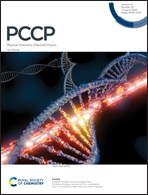Determinants for proton location and electron coupled proton transfer in hydrogen bonded pentafluorophenol–anion clusters†
Abstract
This work reveals the determinant factors for proton locations and electron coupled proton transfer (ECPT) in biologically relevant hydrogen bonded systems. Pentafluorophenol–anion clusters [C6F5O−·H+·A−]− are chosen to model active sites of biological functions, with the anion A− being systematically varied to ensure the proton affinities (PAs) of the anions well cover the referenced PA of C6F5O− from being appreciably smaller, then similar, and to significantly larger. Negative ion photoelectron spectroscopy of these clusters provides spectroscopic evidence showing that proton location in the anionic state is largely following the PA prediction, while ECPT is observed only for the clusters with the anion possessing an electron binding energy (EBE) significantly larger than that of the referenced C6F5O−. Theoretical calculations suggest these clusters are stabilized by forming a single strong hydrogen bond between donor and acceptor, and the associated charge and MO analyses fully support the experimental observations. The current holistic cluster model study indicates that PA is the right determinant that can be used to predict the proton location and describe hydrogen bonding structures, while both PA and EBE of anionic groups play important roles in facilitating the ECPT process.



 Please wait while we load your content...
Please wait while we load your content...